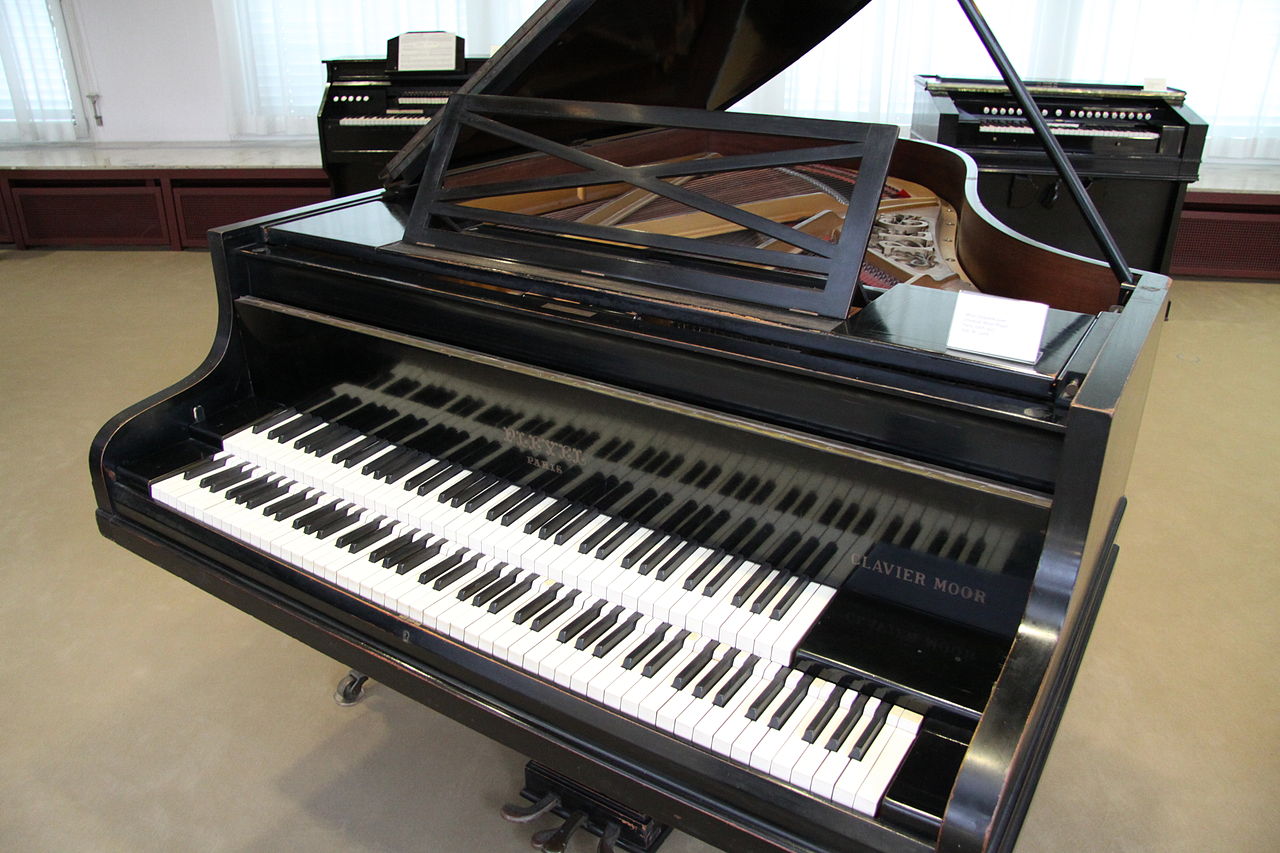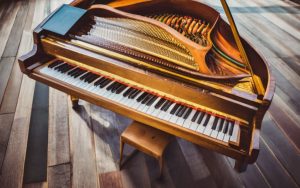Whether you’re a beginner or advanced piano player, find out about the history of this beautiful instrument and connect more deeply with it. Find out how it evolved and became a popular household item. Keep on reading so next time you go to your piano, you’ll see it in a whole new light!

What is piano in music definition?
A piano is a musical instrument that is played using a keyboard. It produces sound by striking strings with hammers that are controlled by the keys on the keyboard. The piano is a member of the percussion family of instruments, as it produces sound through a mechanical action.
The piano has been an essential instrument in music history since its invention. It has been used in countless genres, from classical to pop and rock. The piano has also been the instrument of choice for many famous composers, such as Mozart, Beethoven, and Chopin. Its unique sound has inspired countless musicians and audiences alike, making it a beloved instrument worldwide.
The piano was not the first keyboard instrument to be invented. The earliest keyboard instruments were the hydraulis, the organ, and the harpsichord. These instruments used a mechanism that plucked the strings to create sound, rather than striking them with a hammer. However, in the 1700s, a new type of keyboard instrument emerged: the pianoforte, which would eventually become the piano we know today. The debate of “harpsichord vs piano” often centers around the differences in their mechanisms and sound production.

Cristofori – inventor of the first piano
The first true piano was invented by Bartolomeo Cristofori, an Italian maker of harpsichords. In 1709, Cristofori built the first pianoforte, a keyboard instrument that used hammers to strike the strings. The new instrument had a dynamic range that allowed for both soft and loud playing, a significant improvement over the harpsichord’s limited dynamics.
The Cristofori piano looked and sounded quite different from the modern one we know. He decided that instead of the strings being plucked, as with the harpsichord, it would create more variety in dynamics if the strings were struck with hammers. Watch this video recorded at the Royal Academy of Music museum of pianos. It gives an in-depth look at the inside of an early piano and you can hear the difference in instruments as they were developed.
Early keyboard instruments before the piano
The modern piano was inspired by early keyboard instruments that came before it. These include:
- The monochord, a simple instrument with one string used in ancient Greece for tuning other instruments.
- The polychord, a stringed instrument with multiple strings tuned to different pitches, commonly used in medieval Europe.
- The harpsichord, which became the most popular keyboard instrument in Europe by the early 18th century, but lacked the dynamic range and expression that composers demanded.
Italian harpsichord maker Bartolomeo Cristofori developed the modern piano in the early 1700s. He called it the “gravicembalo col piano e forte,” meaning “harpsichord with soft and loud.” Cristofori’s design was revolutionary because it used a hammer mechanism instead of plucking the strings, which allowed for greater control over dynamics and sustain.
The evolution of the piano
Although Cristofori’s invention was a significant milestone in the evolution of the piano, it would take several decades before it gained widespread popularity. At first, it was mainly used by wealthy patrons and royalty who could afford the high cost of the instrument. However, as the piano evolved and became more affordable, it quickly replaced the harpsichord as the preferred keyboard instrument of the 18th and 19th centuries.
If you’re mildly curious to know what the smallest piano in the world, this is probably it!
Exploring the magic of piano pedals
During this time, the piano underwent several technical innovations that further enhanced its sound and playability. For example, the addition of a third pedal, known as the sustain pedal, allowed performers to create a more resonant and sustained sound. The iron frame, which was introduced in the mid-19th century, allowed for greater string tension and thus increased volume and clarity.
When Cristofori invented the piano, he also invented the piano pedal that would become the standard sustain pedal on every piano.
The piano’s popularity continued to grow throughout the 19th and early 20th centuries, with many famous composers and performers composing and playing music specifically for the instrument. The piano was also used in many different genres of music, from classical to jazz to rock and roll.
Today, the piano remains one of the most popular musical instruments in the world. It continues to be used in a wide range of musical genres and styles, and its influence on music history cannot be overstated. From its humble origins as a new keyboard instrument designed by an Italian harpsichord maker to its current status as a beloved and essential musical instrument, the piano has come a long way in its nearly 300-year history.
The piano in modern times
The evolution of the piano has been characterized by changes in design and technology, advancements in production, and improvements in the sound quality. During the Classical period, the piano underwent various changes in design, with makers experimenting with different materials and mechanisms to improve the sound quality. For example, the addition of pedals to the piano allowed the player to sustain notes, giving the instrument a more expressive sound. The action, or mechanism that strikes the strings, also underwent changes to improve responsiveness and touch sensitivity.
Advancements in the piano continued during the Romantic era, with makers focusing on creating a richer, more powerful sound. One notable innovation during this period was the introduction of cross-stringing, a technique that allowed for longer strings to be used in the instrument, producing a more resonant sound. The iron frame, which provides support for the strings and tension stability, was also introduced during this period.

Emánuel Moór’s double keyboard piano: a rare gem
Another version of this instrument worth mentioning is Emánuel Moór Pianoforte. The main difference between this version and classical versions of a piano is the fact it has double keyboards. The inventor of this interesting instrument was Emánuel Moór (1863 – 1931), a Hungarian composer and pianist. It was made with two keyboards, one above the other. Usually, the lower one had the regular 88 keys, and the upper one was slightly smaller, containing just 76 keys. Playing it was also very unusual. Namely, when a key on the upper was pressed, the mechanism within the instrument would play the matching key on the lower keyboard, just an octave higher.
This mechanism proved to be an advantage because it allowed the pianist to reach two octaves with one hand which couldn’t be achieved when playing the regular piano. It made playing complex pieces (originally composed for double manual harpsichord) doable, since playing them on a single keyboard piano would require extremely difficult, cross hand movements. The Emánuel Moór Pianoforte was never mass-produced. A few piano manufacturers (mostly Bösendorfer, but also Bechstein, Chickering, and Steinway & Sons) have made only about 60 instruments ever.
In the late 19th century, the upright piano was introduced. This new design allowed for a more compact instrument, making it more accessible to the general public. The upright piano also had a different action design, which allowed for faster repetition of notes.
Advancements in technology and digital pianos
Advancements in technology have led to the development of digital pianos, which offer numerous advantages over traditional pianos, such as the ability to produce a wider range of sounds and connect to digital devices. Current trends in piano design and production include the use of sustainable materials, such as bamboo, and the integration of technology into the instrument.
Despite all these advancements, the piano remains a timeless instrument that has stood the test of time. It is a staple in classical music, but has also found a place in modern genres such as pop and rock. The piano continues to inspire new generations of musicians and music lovers alike.
In modern times, with the advent of the internet, it has become easier than ever to learn to play the piano. Online resources such as Skoove offer a range of lessons for beginners and advanced players alike. Skoove.com provides interactive lessons that allow you to learn at your own pace and in the comfort of your own home. With Skoove.com, you can learn to play the piano and achieve your musical goals.
Try out your free trial of Skoove today!














